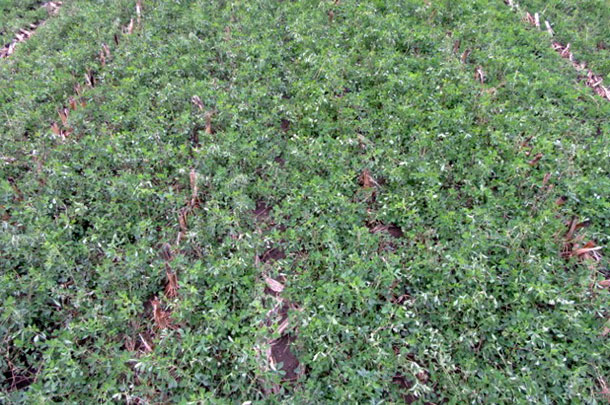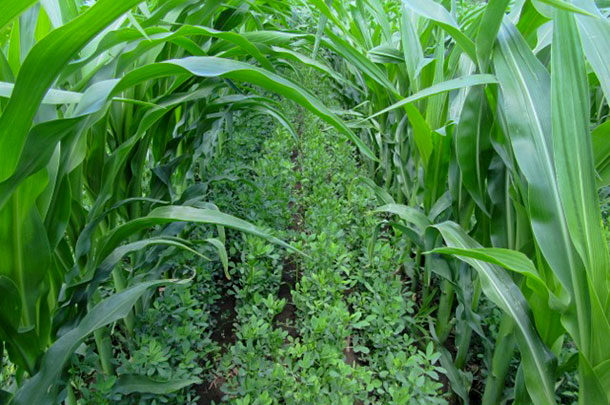Alfalfa and corn silage have complementary nutritional characteristics that benefit livestock when both are included in diets. Thus, growing and feeding alfalfa in conjunction with corn will improve the economic and environmental sustainability of crop and livestock production.
Unfortunately, alfalfa has often been replaced in rotations by corn silage, in part because corn produces greater forage dry matter yield than alfalfa. First-year yields of spring-seeded alfalfa are particularly low, often being one-half that of subsequent full production years. Planting small grain, grass or legume companion crops with alfalfa can modestly improve forage yields in the establishment year, but seeding companion crops often reduces forage quality. Thus, new approaches are needed to increase the yield of alfalfa, especially during its first year of production.
One way to bypass the low-yielding establishment year would be to interseed alfalfa into corn to jumpstart full production of alfalfa the following year. During and after establishment, interseeded alfalfa would also serve as a cover crop to reduce soil and nutrient loss from cropland. Regrettably, this system has been unworkable because traditional intercropping methods require producers to plant corn at low density (sacrificing high silage yields) to allow reliable establishment of alfalfa. Therefore, the USDA’s Agricultural Research Service, the University of Wisconsin and other institutions are working to develop reliable methods for establishing alfalfa in high-yielding silage corn.
During the course of this work in Wisconsin, it has become apparent that successful establishment of alfalfa in corn can be greatly improved by using growth-altering and protective agrichemicals, adapted alfalfa varieties, adequate alfalfa seeding rates and proper timing of alfalfa interseeding after corn planting.
Initial studies from 2008 to 2014 demonstrated that foliar applications of a growth retardant known as prohexadione (PHD) on interseeded alfalfa in June increased seedling survival by 40 to 300 percent under high-yielding corn grown at populations over 30,000 plants per acre. Because of its effectiveness and low toxicity, efforts are now moving forward to register PHD for use on alfalfa interseeded into corn.
Several of these studies also indicated shifting the seeding rate of alfalfa from 8 to 16 pounds per acre increased alfalfa plant density by 32 to 50 percent following corn harvest. Other Wisconsin interseeding studies in 2015 and 2016 with 38 alfalfa varieties found substantial and consistent differences in plant survival, and several conventional varieties had at least a four-fold greater survival rate under corn than the poorest performing varieties.
To facilitate the use of these conventional alfalfa varieties for interseeding, encapsulated acetochlor and bromoxynil were tested and found to have promise as herbicides for controlling weeds.

Work initiated in 2017 found that fungicide and insecticide applied in conjunction with PHD on well-adapted alfalfa varieties further doubled survival of interseeded alfalfa to give excellent stand establishment even when corn was planted at populations of up to 44,000 plants per acre.
Lastly, studies in 2016 and 2017 suggested alfalfa survival under corn was up to 50 percent greater if interseeding was carried out within a few days of corn planting rather than at corn emergence or the two-leaf stage of corn. Ongoing studies will evaluate the use of plant breeding to develop alfalfa varieties specifically designed for interseeding. Other work will aim to optimize agrichemical applications and other management practices to ensure reliable and cost-effective establishment of well-adapted alfalfa varieties in corn.
When successfully established, first-year dry matter yield of interseeded alfalfa was two-fold greater than conventionally spring-seeded alfalfa. In initial studies, alfalfa interseeding reduced silage corn yields by up to 15 percent, but shifting fertilizer nitrogen from the mid- to upper-end of recommended rates largely eliminated yield depression. Future work will identify the best-suited hybrids and corn management practices to ensure high yields with interseeded alfalfa.
The alfalfa interseeding system also holds promise for protecting cropland and improving farm profitability. Rain simulator studies indicated alfalfa interseeding reduced runoff of both soil and nutrients by 40 to 80 percent during and after silage corn production compared with a conventional system where alfalfa was spring seeded after corn silage. Preliminary economic analyses also suggest a reliable alfalfa interseeding system would make short-term rotations workable (e.g., two years of alfalfa followed by three years of corn silage) and approximately $60 per acre more profitable than current rotations (e.g., spring-seeded alfalfa grown for up to three years followed by three years of corn silage). The ultimate goal of this work is to develop reliable and profitable corn-interseeded alfalfa production systems for use on farms in Northern states where alfalfa cannot be successfully established in the fall after corn silage harvest. ![]()
This article first ran in the Vita Plus Forage Foundations newsletter, March 23, 2018.
The authors are from USDA-ARS and the University of Wisconsin – Madison.
PHOTO 1: Interseeded alfalfa grows in corn during the growing season.
PHOTO 2: Interseeded alfalfa is shown in growth six weeks following corn silage harvest. Photos by John Grabber.











